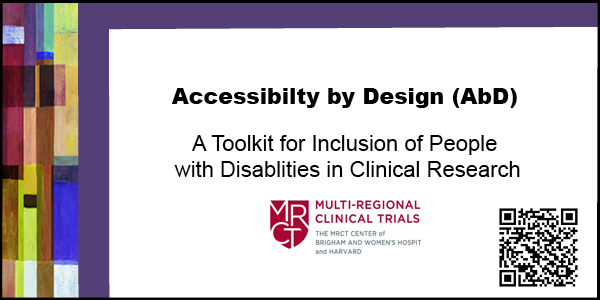By Willyanne DeCormier Plosky, DrPH, Barbara E. Bierer, MD, and the MRCT Center
Efforts in diversity, equity, and inclusion (DEI) should extend beyond race and ethnicity to include sex, gender, age, disability, and other considerations. There are over 1 billion people globally with a disability,1 and people with disabilities make up the largest minority population in the United States.2 Yet, people with disabilities are often excluded from clinical research both as participants and as researchers.3, 4, 5 Without clear justification for scientific, safety, or ethical reasons, such exclusion is both discriminatory and limits the generalizability of study findings.
To support members of the clinical research community in their efforts to involve individuals with a variety of disabilities in clinical research, the Multi-Regional Clinical Trials Center of Brigham and Women’s Hospital and Harvard (MRCT Center) has recently released the Accessibility by Design (AbD) in Clinical Research Toolkit, developed in collaboration with people with disabilities, caregivers, allies, disability rights advocates, research teams, nurses, sponsors, IRB members, and others.
Origins of the AbD Toolkit
The AbD Toolkit grew out of the MRCT Center’s work on Diversity, Equity, and Inclusion in Clinical Research. It aligns with the MRCT Center’s Equity by Design in Clinical Research Metrics Framework, where there are several measures related to the accessibility of participant-facing materials and to site-based or decentralized trial components. The question of how to make progress on these measures then arose. In searching for relevant resources, the MRCT Center found several educational and global health tools, and numerous resources specific to one aspect of accessibility (e.g., web design), but no comprehensive resource tailored to clinical research. The MRCT Center thus sought to collate applicable information and resources, and, where necessary, to create tools to integrate accessibility into clinical research processes.
How Can the AbD Toolkit Be Utilized?
AbD Toolkit users are welcome to review the full document or to focus on specific aspects most relevant to the nature of their work and maturity of their DEI efforts. The AbD Toolkit is broken into five themes:
- A. Planning for AbD: General Considerations
- B. Implementing AbD: Communication Accessibility
- C. Implementing AbD: Physical Accessibility
- D. Innovating AbD: Newer Strategies for Inclusion
- E. Upholding AbD: Accountability and Advocacy
Each theme has key points that are organized into color-coded skill levels (readily achievable, moderate difficulty, advanced goals) and that have hyperlinked references to external tools and training. The AbD Toolkit contains seventeen original tools (or adaptations of tools) specific to clinical research, organized by theme. Examples of these tools include: “Planning inclusive eligibility criteria to reduce exclusion of people with disabilities”; “Changes to outcome measures to reduce exclusion of people with disabilities”; “Modification of the consent form for more inclusive use”; “Map of the participant journey for people with disabilities”; “Features of U.S. supported decision-making statutes”; and “Information brief for individuals asked to act as supporters for supported decision-making.” Together, these tools provide practical and actional guidance to support greater inclusion of people with disabilities throughout the different stages of clinical research planning, conduct, and review.
Invitation to Comment
 The MRCT Center welcomes feedback, suggestions, additional tools and resources, and concerns on the AbD Toolkit. Please email: mrct@bwh.harvard.edu. We look forward to continuing to work together with people with disabilities, their allies, and colleagues involved in clinical research to further the inclusion of people with disabilities in clinical research.
The MRCT Center welcomes feedback, suggestions, additional tools and resources, and concerns on the AbD Toolkit. Please email: mrct@bwh.harvard.edu. We look forward to continuing to work together with people with disabilities, their allies, and colleagues involved in clinical research to further the inclusion of people with disabilities in clinical research.
1. Disability and health. [Internet]. World Health Organization. World Health Organization. Available from: https://www.who.int/news-room/fact-sheets/detail/disability-and-health#:~:text=Over%201%20billion%20people%20are,often%20requiring%20health%20care%20services
2. Disability impacts all of us infographic. [Internet]. Centers for Disease Control and Prevention. Available from: https://www.cdc.gov/ncbddd/disabilityandhealth/infographic-disability-impacts-all.html
3. McDonald K, Schwartz AE, Sabatello M. (2022). Eligibility criteria in NIH-funded clinical trials: Can adults with intellectual disability get in? [Internet]. Disab Health J, 15(4), online ahead of print. Available from: https://pubmed.ncbi.nlm.nih.gov/36123292/
4. DeCormier Plosky W, Ne’eman A, Silverman BC, Strauss DH, Francis LP, Stein MA, et al. (2022). Excluding people with disabilities from clinical research: Eligibility criteria lack clarity and justification. [Internet]. Health Affairs, 41(10):1432-1432. Available from: https://www.healthaffairs.org/doi/10.1377/hlthaff.2022.00520
5. Lauer, M. (2022) Data on researchers’ self-reported disability status. [Internet]. National Institutes of Health Office of Extramural Research. Extramural Nexus, 2022 Dec 13. Available from: https://nexus.od.nih.gov/all/2022/12/13/data-on-researchers-self-reported-disability-status/

The inclusion of people with disabilities in clinical research is crucial for ensuring equitable healthcare outcomes and advancing medical knowledge. By actively involving individuals with disabilities, researchers can gain valuable insights into their unique healthcare needs and develop more effective treatments and interventions that cater to their specific requirements.
Thank you for sharing. It is very informative and helpful.